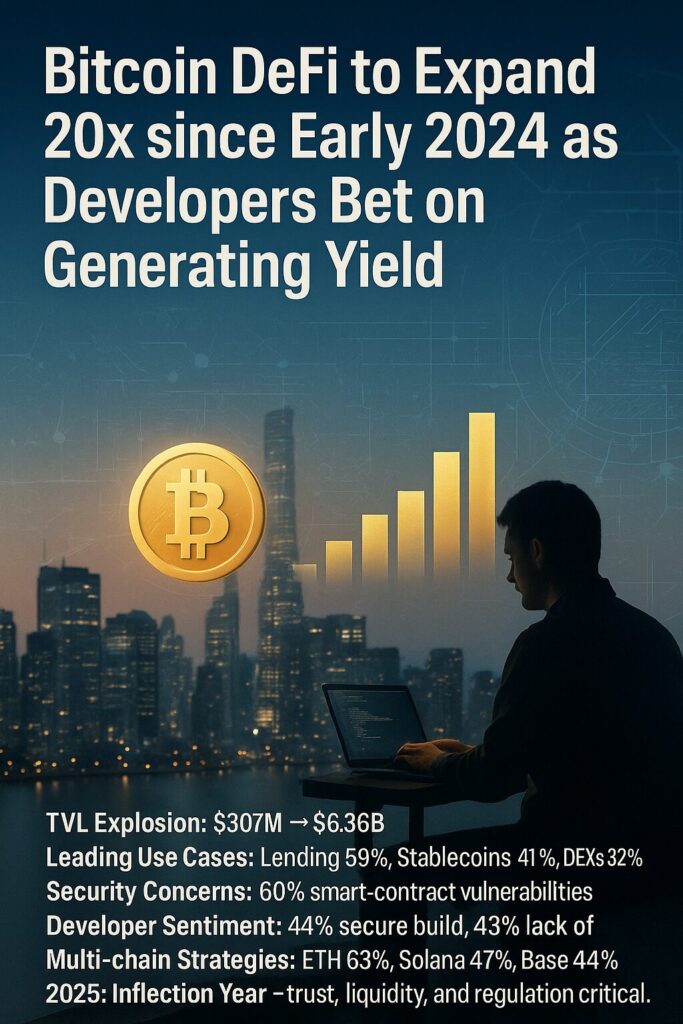
Main Points:
- TVL Explosion: TVL rose from $307 million in January 2024 to $6.36 billion by mid‑2025.
- Leading Use Cases: Lending protocols dominate (59%), followed by BTC‑backed stablecoins (41%), DEXs (32%), and RWA tokenization (29%).
- Security Concerns: 60% cite smart‑contract vulnerabilities as the top risk; 36% prefer cold wallets.
- Developer Sentiment: 44% build on Bitcoin for security; 43% frustrated by lack of native smart contracts.
- Multi‑chain Strategies: 63% on Ethereum, 47% on Solana, 44% on Base.
- Native Infrastructure: ArchVM and other VMs aim to bring smart‑contract parity to Bitcoin.
- Layer‑2 Growth: Lightning yields and Babylon’s LBTC staking gain traction.
- RWA & Institutional Adoption: Tokenized RWAs reached $14 – $19 billion in late 2024; Bitwise forecasts a $200 billion BTC staking market.
- Outlook: 2025 is the inflection year, but trust, liquidity activation, and regulatory clarity remain critical.
1. TVL Explosion: From Niche Experiment to Major Growth
Bitcoin DeFi’s total value locked (TVL) skyrocketed nearly 20×, climbing from $307 million in January 2024 to $6.36 billion by June 2025, according to Arch Network’s report. This surge reflects growing interest in earning yi Bitcoin. The year‑over‑year growth is further underscored by BTCFi’s 2,767% TVL increase, driven by new protocols and cross‑chain integrations .
2. Leading Use Cases: Lending, Stablecoins & Beyond
A survey of 125 developers and users across Asia and Africa shows that lending protocols lead Bitcoin DeFi adoption, with 59% participation. BTC‑collateralized stablecoins follow at 41%, decentralized exchanges at 32%, and tokenized real‑world assets (RWA) at 29%. These figures indicate that DeFi on Bitcoin is shifting from speculative betdity solutions for hodlers .
3. Security & Trust Barriers
Despite rapid growth, trust remains a hurdle. Arch Network found that 36% store a portion of Bitcoin in cold wallets, signaling distrust in live DeFi platforms. Additionally, 60% rank smart‑contract vulnerabilities as their chief security concern .
4. Developer Sentiment & Multi‑chain Strategies
Developers are split between optimiurity and frustration over limited programmability. While 44% cite security and decentralization advantages as reasons to build on Bitcoin, 43% lament the lack of native smart contracts. As a workaround, 63% also build on Ethereum, 47% on Solana, and 44% on Base, illustrating a prevailing multi‑chain strategy .
5. Native Infrastructure: ArchVM & Cointelegraphity
The arrival of VMs like ArchVM—backed by Arch Labs’ $13 million Series A—promises to bring native smart‑contract capabilities to Bitcoin, removing reliance on bridges .
6. Layer‑2 & Bridge Solutions
Layer‑2 networks, especially Lightning, are increasingly seen as DeFi contenders. Blockstream’s Lightning yields enable instant,TC interest without off‑chain custody . Trustless bridges with enhanced security—such as federated and zk‑based approaches—are under development to bootstrap liquidity.
7. RWA Integration & Institutional Adoption
The broader DeFi space saw RWAs grow to $14 – $19 billion by late 2024, largely on Ethereum and L2s; Bitcoin’s limited programman the sidelines, but future integration could attract conservative capital seeking yield . Bitwise predicts a $200 billion addressable market for Bitcoin staking alone .
8. Outlook: The Inflection Point of 2025
Multiple indicators point to 2025 as a pivotal year. Regulatory clarity—like the upcoming stablecoin legislation under the GENIUS and STABLE Acts—will shape DeFi. Institutional engagement, new Bitcoin VMs, and Layer‑2 maturation could activate the dormant $2 trillion Bver, achieving deeper liquidity, robust security, and user trust remains essential.
Conclusion
Bitcoin DeFi has evolved from a peripheral experiment to a vibrant sector with multi‑billion‑dollar TVL and growing devle security, trust, and technical limitations pose challenges, innovations in native infrastructure, Layer‑2 solutions, and RWA integration herald a new era. If Bitcoin holders can confidently deploy their assets in trustless, yield‑generating applications, the stage is set for Bitcoin to move beyond “digital gold” into a fully programmable, productive financial instrument.

